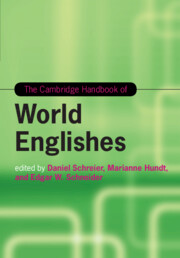Book contents
- The Cambridge Handbook of World Englishes
- Cambridge Handbooks in Language and Linguistics
- The Cambridge Handbook of World Englishes
- Copyright page
- Dedication
- Contents
- Figures
- Maps
- Tables
- Notes on Contributors
- 1 World Englishes: An Introduction
- Part I The Making of Englishes
- Part II World Englishes Old and New
- Part III Linguistics and World Englishes
- 14 The Global Growth of English at the Grassroots
- 15 Beyond English as a Second or Foreign Language: Local Uses and the Cultural Politics of Identification
- 16 World Englishes in Cyberspace
- 17 World Englishes and Their Dialect Roots
- 18 Lexicography and World Englishes
- 19 The Relevance of World Englishes for Variationist Sociolinguistics
- 20 Multilingualism and the World Englishes
- 21 Unearthing the Diachrony of World Englishes
- 22 Corpus-Based Approaches to World Englishes
- 23 World Englishes from the Perspective of Dialect Typology
- 24 Language Acquisition and World Englishes
- Part IV Current Challenges
- Index
- References
17 - World Englishes and Their Dialect Roots
from Part III - Linguistics and World Englishes
Published online by Cambridge University Press: 16 December 2019
- The Cambridge Handbook of World Englishes
- Cambridge Handbooks in Language and Linguistics
- The Cambridge Handbook of World Englishes
- Copyright page
- Dedication
- Contents
- Figures
- Maps
- Tables
- Notes on Contributors
- 1 World Englishes: An Introduction
- Part I The Making of Englishes
- Part II World Englishes Old and New
- Part III Linguistics and World Englishes
- 14 The Global Growth of English at the Grassroots
- 15 Beyond English as a Second or Foreign Language: Local Uses and the Cultural Politics of Identification
- 16 World Englishes in Cyberspace
- 17 World Englishes and Their Dialect Roots
- 18 Lexicography and World Englishes
- 19 The Relevance of World Englishes for Variationist Sociolinguistics
- 20 Multilingualism and the World Englishes
- 21 Unearthing the Diachrony of World Englishes
- 22 Corpus-Based Approaches to World Englishes
- 23 World Englishes from the Perspective of Dialect Typology
- 24 Language Acquisition and World Englishes
- Part IV Current Challenges
- Index
- References
Summary
This chapter investigates the persistence and development of so-called dialect roots, that is, features of local forms of British English that are transplanted to overseas territories. It discusses dialect input and the survival of features, independent developments within overseas communities, including realignments of features in the dialect inputs, as well as contact phenomena when English speakers interact with those of other dialects and languages. The diagnostic value of these roots is exemplified with selected cases from around the world (Newfoundland English, Liberian English, Caribbean Englishes), which are assessed with reference to the archaic/dynamic character of individual features in new-dialect formation and language-contact scenarios.
Keywords
- Type
- Chapter
- Information
- The Cambridge Handbook of World Englishes , pp. 384 - 407Publisher: Cambridge University PressPrint publication year: 2020
References
- 2
- Cited by



